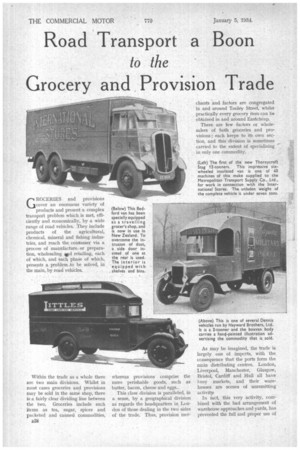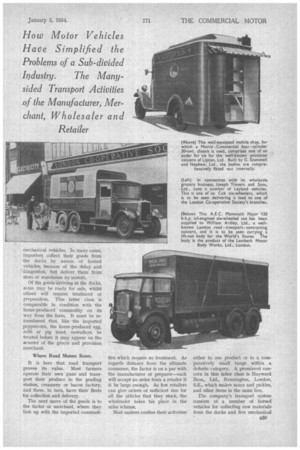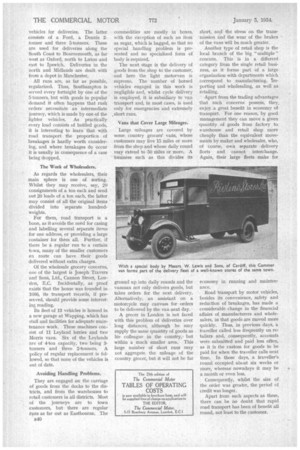Road Transport a Boon
Page 52

Page 53

Page 54

If you've noticed an error in this article please click here to report it so we can fix it.
to the
Grocery and Provision Trade
GROCERIES and provisions cover an enormous variety of products and present a complex transport problem which is met, efficiently and economically, by a wide range of road vehicles. They include products of the agricultural, chemical, mineral and fishing industries, and reach the consumer via a process of manufacture. or preparation, wholesaling *id retailing, each of which, and each phase of which, presents a problem...to be solved, in the main, by road vehicles.
Within the trade as a whole there are two main divisions. Whilst in most cases groceries and provisions may be sold in the same shop, there is a fairly clear dividing line between the two. Groceries include such items as tea, sugar, spices and packeted and canned commodities, 'Whereas provisions comprise the more perishable goods, such as butter, bacon, cheese and eggs.
This class division is paralleled, in a sense, by a geographical division as regards the headquarters in London of those dealing in the two sides of the trade. Thus, provision mer chants and factors are convegated in and around Tooley Street,whilst practically every grocery item can be obtained in and around Eastcheap. There are few -factors or wholesalers of -both groceries and provisions; each keeps to its own section, and this -division is .sometimes carried to the extent of specializing in only one commodity.
As may be imagined, the trade is largely one of impeits, with the cc,nsequence that the ports form the
main distributing centres. London, Liverpool, Manchester, Glasgow, Bristol, Cardiff and Hull all have busy markets, and their warehouses are scenes of unremitting ctivity In tact, this very activity, com bined with the bad arrangement of warehouse approaches and yards, has prevented the full and proper use of mechanical vehicles. In many cases, importers collect their goods from the docks by means of horsed vehicles, because of the delay and congestion, but deliver them from store. or warehouse by motors.
Of the goods arriving at the dock, some may be ready for sale, whilst others will require treatment or preparation. This latter class is • comparable in condition with the home-produced commodity on its way from the farm. It must be remembered that, like the imported peppercorn, the home-produced egg, milk or pig must, • nowadays, be treated before it may appear on the oounter of the grocer and provision merchant.
Where Road Motors Score.
It is here that road transport proves its value. Most farmers operate their own yans and trans'port their produce to the grading station, creamery or bacon factory, and these, in turn, have their fleets for collection and delivery.
The next move of the goods is to the factor or merchant, where they link up with the imported conunodi
ties which require no treatment. As regards distance from the ultimate consumer, the factor is on a par with the manufacturer or preparer—each will accept an order from a retailer if it be large enough. As few retailers can give orders of sufficient size for all the articles that they stock, the wholesaler takes his place in the sales scheme.
Most makers confine their activities either to one product or to a comparatively small range within a definite category. A prominent concern in this latter class is Hayward Bros., Ltd., Kennington, London, S.E., which makes sauce and pickles, and other items in the same line.
The company's transport system consists of a number of horsed vehicles for collecting raw materials from the docks and five mechanical vehicles for deliveries. The latter consists of a Ford, a Dennis 2tonner and three 5-tonners. These are used for deliveries along the South Coat to Bournemouth, as far west as Oxford, north to Luton and east to Ipswich. Deliveries in the north and Midlands are dealt with from a depot in Manchester.
All runs are, as far as possible, regularized. Thus, Southampton is served every fortnight by one of the 5-tonners, but with goods in popular demand it often happens that rush orders necessitate an intermediate journey, which is made by one of the lighter vehicles. As practically every load consists of bottled gcods, it is interesting to learn that with road transport the proportion of breakages is hardly worth considering, and where breakages do occur it is usually in consequence of a case being dropped.
The Work of Wholesalers.
As regards the wholesalers, their main sphere is one of sorting. Whilst they may receive, say, 20 consignments of a ton each and send out 20 loads of a ton each, the latter may consist of all the original items divided into *separate hundredweights.
For them, road transport is a boon, as it avoids the need for casing and labelling several separate items for one address, or providing a large container for them all. Further, if there be it regular run to a certain town, many of the smaller customers en route can have their goods delivered without extra charges.
Of the wholesale grocery concerns, one of the largest is Joseph Travers and Sons, Ltd., Cannon Street, London, B.C. Incidentally, as proof exists that the house was founded in 1666, its transport records, if preserved, should provide some interesting reading.
Its fleet of 13 vehicles is housed in a new garage at Wapping, which has staff and facilities for adequate maintenance work. These machines consist of n Leyland lorries and two Morris vans. Six of the Leylands are of 4-ton capacity, two being 3tonners and three 2-tonners. A policy of regular replacement is followed, so that none of the vehicles is out of date.
Avoiding Handling Problems.
They are engaged on the carriage of goods from the docks to the districts, and from the warehouses to retail customers in all districts. Most of the journeys are to town customers, but there are regular runs as far out as Eastbourne. The B40 commodities are mostly in boxes, with the exception of such an item as sugar, which is bagged, so that no special handling problem is presented and no specialized form of body is required.
The next stage is the delivery of goods from the shop to the customer, and here the light motorvan is supreme. The number of horsed vehicles engaged in this work is negligible and, whilst cycle delivery is employed, it is subsidiary to van transport and, in most cases, is used only for emergencies and extremely • short runs.
Vans that Cover Large Mileages.
Large mileages are covered by some country grocers' vans, whose customers may live 15 miles or more from the shop and whose daily round may extend to 50 miles or more. A business such as this divides its ground up into daily rounds and the vanman not only delivers goods, but takes orders for the next delivery. Alternatively, an assistant on a motorcycle may canvass for orders to he delivered by the van next day.
grocer in London is not faced with this problem of deliveries over long distances, although he may supply the same quantity of goods as his colleague in the conntry,but within a much smaller area. This large number of short runs may not aggregate the mileage of the country grocer, but it will not be far short and the stress on the transmission dnd the wear of the brakes of the vans will be much greater.
Another type of retail shop is the local branch of the big " multiple " concern. This is in a different category from the single retail business, as it forms part of a large organization with departments which correspond to manufacturing, Importing and wholesaling, as well as retailing. .
Apart from the trading advantages that such concerns possess, they enjoy a great benefit in economy of transport. For one reason, by good management they can move a given quantity of goods from factory to warehouse and retail shop more cheaply than the equivalent movements by maker and wholesaler, who, of course, own separate delivery fleets and cannot interchange. Again, their large fleets make for economy in running and maintenance.
Road transport by motor vehicles, besides its convenience, safety' and reduction of breakages, has made a considerable change in the financial affairs of manufacturers and wholesalers, in that goods are moved more quickly. Thus, in previous days, a traveller called less frequently on retailers and, consequently, accounts were submitted and paid less often, as it is the custom for goods to be paid for when the traveller calls next time. In those days, a traveller's round occupied about six weeks or more, whereas nowadays it may be a month or even less.
Consequently, whilst the size of the order was greater, the period of credit was longer.
Apart from such aspects as these, there can be no doubt that rapid road transport has been of benefit all round, not least to the customer.




























































































